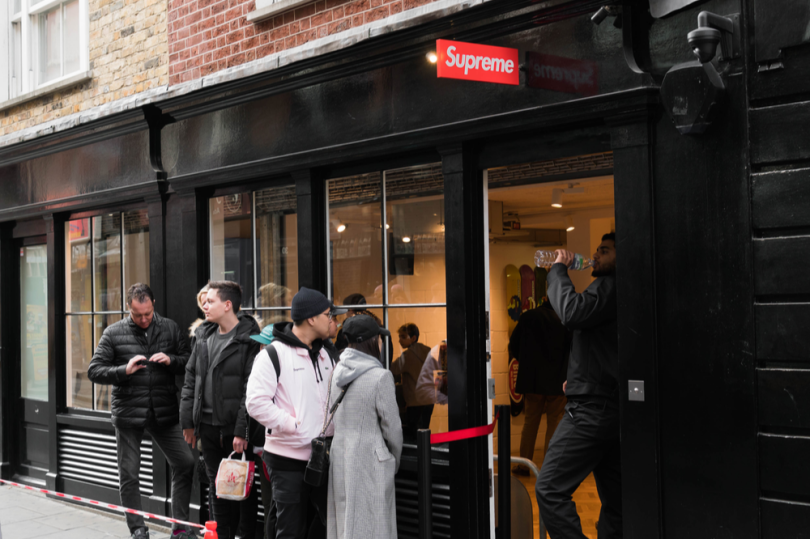OnlyTweets dropped on a Wednesday. The software product, which allows Twitter users to lock their accounts behind a subscription paywall, had gone from an idea jotted down in a shared document to a shipped release in less than a week. Put suddenly out into the wild with no advance warning, it was nevertheless met with a flurry of signups.
OnlyTweets was a “drop” from Stir, a tech startup whose platform helps creators manage their back-office work.
For decades, drops have been integral to the word-of-mouth marketing efforts of streetwear and sneaker brands. The controlled, sometimes surprise release of limited-edition products generates and accelerates hype, brand loyalty and community engagement.
Lately, though, drops are making their way from physical goods to software services, as some companies apply the buzz-building strategy to their digital product releases.

What’s Droppin’?
Stir has made a name for itself by releasing gimmicky one-off software products — like one that lets TikTok users download their entire content library in one file (FYP.RIP) and another that facilitates random merch collabs between creators (MerchWith) — but it’s not the only one.
Every two weeks, the Brooklyn-based collective MSCHF releases another viral stunt, which it calls a drop. Some of these drops are physical products — like its “Satan Shoes” collaboration with musical artist Lil Nas X, which prompted a lawsuit from Nike — but many of them are digital, and all of them appear designed with the sole purpose of grabbing headlines.
A random sampling of MSCHF’s digital drops includes Times Newer Roman, a font that looks like Times New Roman but with each character slightly wider, to help students meet page-length requirements; Netflix Hangouts, a browser add-on that lets users watch Netflix at work by making it look like they’re on a conference call; and Finger on the App, a one-time contest in which the person who kept their finger continuously pressed against their smartphone screen for the longest amount of time won $25,000.
While Stir and MSCHF are widely considered the two major forces in this space today, digital drops have also been used in more straight-laced ways by several prominent brands.
HotelTonight, the last-minute hotel-booking app, rolled out a “Daily Drop” feature in which users could access daily lodging discounts — but they only had 15 minutes to apply the deal after unlocking it.
Amazon gave Prime members a 24-hour window to watch the first episode of its television series Hannah a month ahead of its official premiere date; if they missed the time frame, they’d have to wait.
Cash App dropped a 99-percent-off anywhere “Boost,” which users could activate if they used it within 20 minutes of the discount’s announcement.
“We used merch drops as a huge source of inspiration for Boosts back in the day,” Brandon Jacoby, former growth product design lead at Cash App, tweeted in response.
Bobby Thakkar, co-founder of the creative studio Ampersand, told Built In he’s been approached by “maybe three dozen companies” in recent months, all asking him to lead their digital drops programs.
“A lot of companies are thinking about it,” he said. “I think it’s going to be coming out more and more.”
Drops Help Maintain Consistent Buzz
Only recently in history has it become achievable for scrappy startups to launch minimum viable products (MVP) with such incredible velocity. That said, companies have several reasons to consider shipping digital product drops beyond merely having the ability to do so.
For one, drops provide a way for companies to generate a steady drumbeat of press coverage and brand awareness while they’re in between proper, fully fledged product releases.
Before Stir launched its core business platform, for instance, it created OnlyTweets to draw media attention to a point it wanted to make — in this case, that the big social media companies don’t do enough to help creators monetize their work.
“It’s a marketing stunt,” Thakkar, who worked for Stir when it released OnlyTweets, said. “It’s essentially a way for us to relay a message quickly, get press and make a statement.”
“It’s a marketing stunt. It’s essentially a way for us to relay a message quickly, get press and make a statement.”
Releasing drops is also an effective way for brands to engage their community and keep customers consistently excited, according to Andrew Watts, marketing lead at Simulate, a startup that hid limited-edition drops of dinosaur-shaped vegan nuggets around New York City to promote its plant-based food brand.
“I feel like a lot of brands don’t have the luxury of their audience looking forward to something from them,” Watts told Built In. “Just doing a product release doesn’t have the sense of urgency or dopamine rush associated with it.”
Drake Rehfeld, principal at the early stage venture firm Day One Ventures, told Built In drops turn an otherwise passive shopping experience into one which brands “create a few moments of attention that require somebody to direct their entire brain power toward the purchase experience to buy.”
In the process of shopping a drop, people “often learn everything about the brand story, or the artists that made it,” Rehfeld added. “It’s powerful from the brand perspective.”
“Just doing a product release doesn’t have the sense of urgency or dopamine rush associated with it.”
While drops can lead to immediate revenue, that’s not typically the business’ main objective in doing it (unless they’re released frequently and consistently). More than anything, it’s a long-term brand equity play, Pierre-Yann Dolbec, assistant professor of marketing at Concordia University in Montreal, told Built In.
Dolbec has spent the past several years researching the sociology of sneaker culture. He said that all of the time people spend on blogs and social media to speculate about future drops and discuss the success of previous ones adds up to lots of value for the brand.
“It affects [the company’s] market cap, not necessarily its revenue,” he said.
We’ve Reached Peak Drop
Drops originated in Japanese streetwear brands in the 1990s before spreading to the United States, where the technique was popularized by brands like Supreme and The Hundreds. Now, drops play a prominent role in Nike’s direct-to-consumer strategy.
Drops have also infiltrated the mainstream, going way beyond sneaker culture. Luxury fashion brands, fast-food restaurants and enterprise software companies have cashed in on the marketing stunt, hoping to seize cultural moments for themselves by making viral splashes. Even the proliferation of pop-up shops can be traced back to drop culture.
The research firm PYMNTS found that 43 percent of the nearly 2,300 consumers it surveyed had participated in product drops, flash sales and private sales within the past month, including 60 percent of respondents who were Xennials or younger.
So, What Makes a Drop?
What differentiates digital product drops from physical ones is obvious. Less obvious, though, is what distinguishes digital drops from everyday software updates or product releases.
Are the latest versions of Windows or MacOS examples of drops?
Not quite.
A drop, Thakkar said, is usually carried out for a limited time, and with no intention of maintaining it or improving it after its release.
“It can be built not to scale,” he added. “And that gives you the power to build things very quickly.”
Plus, Thakkar continued, “the intention [with drops] is not to make money, it’s not to be your core product, it’s not to be there for a long time.”
Watts compared software drops to mini product releases.
“They’re not meant to be sustainable long-term businesses; that’s kind of the point,” he said. “A lot of times during drops, you cut corners, or don’t think of edge cases, or don’t think of the end user experience, or how this is going to [make 10 times] revenue — it’s more so just focused on creating the best MVP you possibly can, and just shipping it.”
Why Drops Work
Nothing activates our lizard brains quite like shopping a drop. The ploy is designed to maximize hype and exclusivity, sending our scarcity mindsets into overdrive.
Kelly Goldsmith, a professor of marketing at Vanderbilt University who researches how consumers respond to scarcity and uncertainty, said when our access to goods or services is threatened, we’re given a shock to the system, an adrenaline rush that urges us to act quickly — or else.
“It gets our blood pumping,” Goldsmith told Built In. “If you think back to us being cave people, if our access to food or water or shelter was scarce, we needed to have the energy to do something about it. And we just haven’t totally shaken that yet.”
“The need for uniqueness is definitely one of the reasons why people are attracted to these scarce goods,” Goldsmith added, “above and beyond the fact that we salivate when the bell rings with scarcity.”
“The need for uniqueness is definitely one of the reasons why people are attracted to these scarce goods.”
Indeed, people often resort to desperate measures to get their hands on exclusive items and keep FOMO at bay — like creating web-crawling bots, camping overnight outside of stores, even turning to violence.
Even though merch drops rely on physical scarcity — they are limited-edition products, after all, and there’s no such thing as infinite inventory — software drops can be used to a similar effect. Their release moment just has to be marked as special, or given a countdown timer, for example.
“You don’t actually need true physical scarcity, you just need to imply psychological scarcity,” Rehfeld said, “which is legitimate if you’re involved in [a particular] moment in time.”

The Inevitable Normalization of Software Drops
Software drops are mainly being used today by younger, edgier brands that already have cultivated digitally native audiences. But how long until B2B software companies, for example, start employing drops, fueling the fandom of their SaaS tool hypebeasts?
Thakkar’s guess is that the first step will be for such businesses to get deeper into content and media, to start thinking like consumer-oriented companies. He pointed to Hubspot’s acquisition of media company The Hustle as a decisive step toward entertainment, “which is one step closer toward drops, if they take it all the way there.”
“As B2B brands start to develop a personality and focus on consumer and media, I think we’re gonna see more brands play on drops,” he added. “Drops pull on a lot of human emotions in terms of limited supply; very intentional, very mission driven. And that’s just good marketing in my book.”




